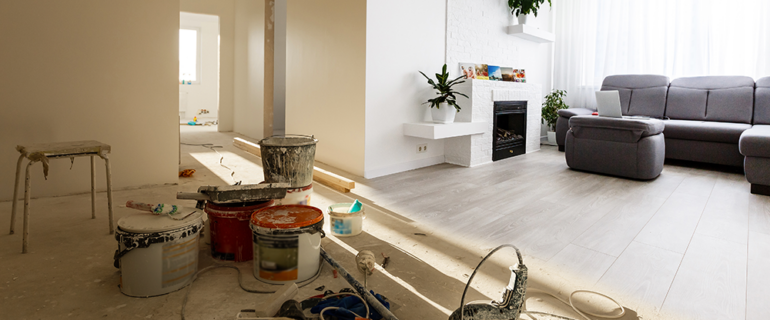Whether you’re seeking to increase the value of your property, tailor your home to your requirements or make it more energy-efficient, home improvements can be costly.
However, you may not want to wait months or years to save the money you need to fund your renovations.
This is where home improvement loans can help, as they allow you to pay for your renovations immediately and spread the cost across monthly payments for several months or years.
Here’s what you need to know if you’re considering a home improvement loan.
This loans eligibility service is powered by Monevo. The data you supply is directly submitted to Monevo and is used to retrieve loan quotes from Monevo’s panel of lenders, other loans are available in the UK loans market that are not included in this service. By using their loans eligibility service you are agreeing to Monevo’s terms and conditions and privacy policy which can be found at Monevo.co.uk. Neither Monevo or Nerdwallet Ltd carry out credit repair services. Late repayment can cause you serious money problems.
What is a home improvement loan?
Home improvement loans are standard loans that you can take out to fund repairs, renovations, extensions or other improvements to a property that you own.
For example, you can take out a home improvement loan for a range of renovations, including:
- a loft conversion
- an extension
- redecorating one or more rooms
- building a conservatory
- a new kitchen or bathroom
- energy-efficient improvements e.g. insulation, double-glazing.
Whether your planned renovations are small or large, a home improvement loan can help you to pay for the work and materials needed to complete them.
How do home improvement loans work?
There are a number of types of home improvement loans, but they will typically pay you a lump sum which you will then repay in monthly instalments over an agreed term.
Loans can be used to cover the full cost of the renovations or a portion of the overall costs, with the remaining capital coming from elsewhere, such as your savings.
You apply for a home improvement loan in the same way as any other loan. Often, you will also be able to check your eligibility before applying without affecting your credit score.
When you apply for a loan, the lender will ask you for some personal and financial details, including what you plan to use the money for. You may not be asked for any more information beyond saying it’s for home improvements, but, in some cases, the lender may ask for more details.
Lenders will look at your income and regular spending, as well as the other information you provide, to decide whether to offer you a loan. It will also run a credit check as part of the application process, which will be recorded on your credit file.
If you’re eligible, lenders will use this information to decide what interest rate to charge.
Once your application is approved and you have the money in your account, you can begin spending it on your home improvement project. You will need to repay the loan according to the terms of your agreement until it is paid off in full.
Types of home improvement loans
Unsecured home improvement loans
An unsecured loan can be used to fund work on your house. You can typically borrow up to £25,000 with an unsecured loan, although some lenders may offer more.
Because the loan isn’t secured on any property, the lender does not have an automatic claim against your home if you can’t make your repayments.
To get the best interest rates on unsecured loans, you will need a good credit score and show that you can comfortably afford the repayments.
» MORE: How do bank loans work?
Secured home improvement loans
You can also use a secured loan to pay for home improvements, with the money being borrowed against the equity or value of your home.
You could apply to borrow more with a further advance from your current mortgage provider. This can work in different ways, depending on your provider, but it will typically be a separate agreement from your current mortgage and involve affordability checks.
You could also consider a secured loan from a new lender or remortgage to release equity in your home.
If you’re unable to pay back the loan as promised, the lender can take back the money you owe from the equity that you’ve built up in your house. For this reason, it’s important to carefully consider whether this type of loan is right for you, and make sure you can meet your monthly repayments as your home may be at risk if you fail to do so.
Interest rates for secured loans are usually lower than for unsecured loans, as you have minimised the risk for your lender by offering your home as security. You can also typically borrow more with a secured loan and repay it over a longer period.
» MORE: What is a secured loan?
How much could I borrow with a home improvement loan?
The amount you can borrow will typically depend on your credit score, financial situation and whether you choose an unsecured or secured loan. Typically, you will be able to borrow up to £25,000 with an unsecured loan, which you can use towards your renovation and improvement projects.
If you need a larger sum, you may need to take out a secured loan.
You will generally be able to borrow tens of thousands, or even hundreds of thousands, with a secured loan, although the amount you can actually borrow will depend on the value of the equity you own in your house, as well as other factors such as your credit score and income.
Pros and cons of home improvement loans
There are several pros and cons to think about if you’re considering taking out a loan to pay for home improvements.
Advantages of home improvement loans
- You can start the work sooner than if you waited to save up the money.
- It can be relatively quick to apply for an unsecured loan and get the money in your account. Secured loans typically take longer.
- The improvements may add value to your property, although this isn’t guaranteed.
- Taking out a separate loan instead of remortgaging to borrow the extra money means you can keep your existing mortgage agreement and interest rate.
Disadvantages of home improvement loans
- You will pay interest on the loan, so it will cost you more than if you used your own money.
- If you have a bad credit score, you may be charged a higher rate of interest.
- If the loan is secured, your house is at risk of repossession if you fall behind on repayments.
Is it worth getting a loan for home improvements?
It may be worth taking out a loan for home improvements if you’re planning some renovations but don’t have the cash to pay for them upfront. Taking out a loan means you don’t need to wait until you’ve saved up enough money before starting the work.
But it’s worth considering how essential the works are. If they’re not urgent, it may be better to wait and save up the money to pay for all, or part, of the work instead of getting a loan.
If you do take out a loan, you should always make sure you can afford to repay it in full and on time. It’s also important to consider all the risks involved, especially if you take out a secured loan that uses your property as collateral.
If you’re not confident that you can make the necessary payments, then it would be better to wait and reassess your options.
What to consider when applying for a home improvement loan
Before taking out a loan to pay for home improvements, it’s worth considering the following points.
- When do you need the work completed? If you don’t need to do the improvements immediately, it may be worth waiting and saving up some money to fund part, or all, of the work. Waiting before taking out a loan could also allow you to improve your credit score and improve your chances of getting a loan with a lower interest rate.
- How much does the work cost? Make sure you get several quotes for your renovations so you don’t pay over-the-odds and so you know how much you need to borrow. You should only borrow the amount you need and not take out a bigger loan just because you’re eligible.
- Check the firm you plan to use is reputable and registered to do the necessary work. To minimise the risk of problems in the future that could end up costing you even more money, make sure you thoroughly research firms to make sure they’re qualified to do the work.
- How much can you afford to repay each month? You should work out a budget to see what you can comfortably afford to repay. This will help you see how much you can borrow and how long you need to make repayments. But, the longer the term, the more you’re likely to pay in interest overall.
- Have you compared lenders? It’s a good idea to compare different lenders to help you find the best loan for your situation. You can also use an eligibility service that looks at multiple lenders to see what loans you could qualify for.
- Have you considered alternatives to a loan? Taking out a loan to pay for renovations may only sometimes be the best option. There are other sources of funding that you could consider instead of a loan, such as a credit card.
- Are you improving your home’s energy efficiency? If so, you may be able to get a loan with a lower rate or be eligible for funding from your energy supplier or local council, for example.
» MORE: Should I move house or make home improvements?
Alternatives to home improvement loans
Friends and family
If you have any friends or family members that can afford to lend you some money, it may be worth asking them for a loan. But, while this can be a cheaper option than taking out a formal loan, it isn’t a decision that should be taken lightly.
You should consider the impact the loan could have on your relationship and what could happen if things don’t work out. Putting the loan agreement in writing, including the terms of repayment and what happens if you can’t repay the loan, can minimise the chances of things going wrong in the future.
Make sure you only borrow from someone you know and trust. Be wary if someone offers you a loan as they could be an illegal loan shark.
Credit cards
If you only need to borrow a small amount for a short amount of time, you might consider using a credit card to finance the necessary work.
There are many credit card providers offering low or 0% interest periods on purchases or balance transfers – but keep an eye on the deal end dates as, if you still have outstanding debt on your card after this time, you may end up paying much more interest than you would on a standard loan.
Remortgaging
If you want to borrow a larger amount and you have a mortgage on your home, you may want to consider remortgaging.
Depending on your situation and your lender, you may be able to remortgage and borrow a larger sum than you currently owe, using the excess to pay for your home improvements. While this means you only need to make one set of repayments, there are other factors you need to consider before making such an important decision.
For example, you need to think about when your current deal ends, whether you would need to pay any charges to remortgage, and how long the repayment term is. You should also consider the rate you are currently on and how much it would cost overall if you remortgage with a new deal, as it may make sense to keep your current mortgage if you’re on a competitive rate of interest.
In both cases, you should ensure that monthly repayments will be manageable across the term of the loan, even if your circumstances change.
WARNING: Think carefully before securing other debts against your home. Your home may be repossessed if you do not keep up repayments on a loan or any other debt secured on it.
Dive even deeper

Emergency Loans, Grants and Other Support if You Need Money Urgently
Emergency loans can help when you’re faced with an urgent, unexpected expense. But they are usually expensive, and it’s best to look into alternatives first.

Short Term Loans for Bad Credit: Should I Get One?
You may be able to find short term loans for bad credit, but they can be an expensive form of borrowing. It’s important to think carefully about whether a short term loan is right for you before applying for one.

The Invisible Debt of Borrowing From Friends and Family
Three in five UK adults have asked to borrow money from their friends or family, with more than a third needing it for a bill, a new survey has found. Find out more about this hidden world of borrowing and how it can go wrong.






